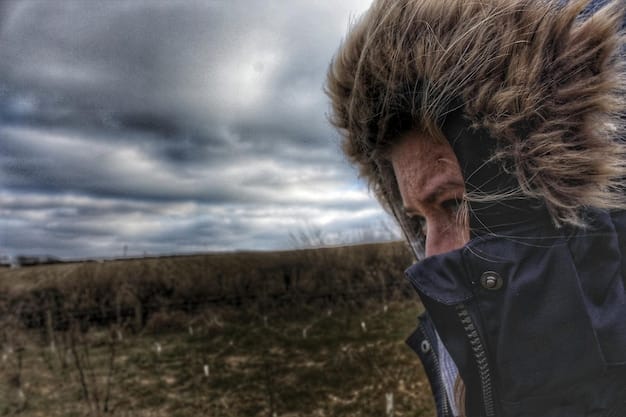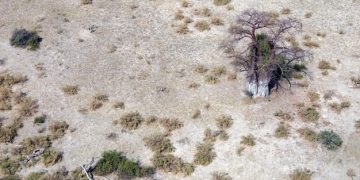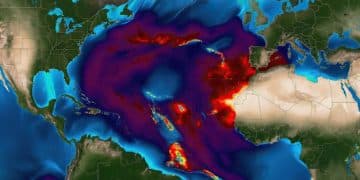Long-Term Health Impacts of Extreme Weather Exposure

Exposure to extreme weather conditions can lead to diverse and significant long-term health consequences, ranging from chronic respiratory and cardiovascular issues to mental health disorders and increased susceptibility to infectious diseases, demanding comprehensive public health strategies.
In an era marked by increasingly volatile climates, understanding what are the long-term health impacts of exposure to extreme weather conditions? becomes not just an academic exercise but a pressing necessity. As our planet undergoes climatic shifts, the frequency and intensity of events like heatwaves, severe storms, droughts, and wildfires are unmistakably rising, casting a profound and often unseen shadow over human health well beyond the immediate aftermath.
The silent toll of temperature extremes: heat and cold
Elevated temperatures, particularly prolonged heatwaves, present a significant public health challenge, extending far beyond the immediate risks of heatstroke and dehydration. The physiological strain imposed by sustained heat exposure can have insidious long-term effects on various bodily systems. Recognizing these cumulative impacts is crucial for developing effective mitigation and adaptation strategies, as global temperatures continue their upward trajectory.
Cardiovascular strain and kidney damage
Prolonged exposure to high temperatures compels the heart to work harder, increasing blood flow to the skin to facilitate cooling. This sustained effort can exacerbate pre-existing cardiovascular conditions, leading to chronic heart strain. Over time, this might contribute to the progression of conditions like congestive heart failure and ischemic heart disease. The kidneys are also highly vulnerable, as dehydration during heatwaves can lead to acute kidney injury, which, if repeated or severe, can progress to chronic kidney disease.
- Increased risk of chronic heart conditions in vulnerable populations.
- Accelerated progression of kidney dysfunction due to dehydration.
- Electrolyte imbalances leading to long-term neurological issues.
- Exacerbation of respiratory illnesses due to increased ozone and particulate matter.
Beyond the immediate cardiovascular and renal concerns, extreme heat can profoundly impact metabolic processes. Sustained heat stress can disrupt glucose regulation, potentially worsening diabetes management or even contributing to its onset in predisposed individuals. This metabolic dysregulation stems from a combination of dehydration, electrolyte imbalances, and the systemic stress response, highlighting the complex interplay between environmental factors and internal physiological balance. Children and the elderly are particularly susceptible to these nuanced long-term effects, often lacking the physiological resilience to fully recover from repeated heat exposures.
Respiratory health and air quality degradation
Heatwaves frequently coincide with stagnant air masses, trapping pollutants near the ground and intensifying air quality issues. Elevated temperatures also promote the formation of ground-level ozone, a potent respiratory irritant. This combination of factors significantly impacts lung health, particularly for individuals with asthma, chronic obstructive pulmonary disease (COPD), or other pre-existing respiratory conditions. Long-term exposure to these degraded air conditions can lead to chronic inflammation, reduced lung function, and increased susceptibility to respiratory infections, setting the stage for a lifetime of compromised breathing.
The interplay between extreme heat and air pollution extends beyond direct respiratory irritation. Ultrafine particles, often associated with urban pollution and exacerbated by temperature inversions, can penetrate deep into the lungs and even enter the bloodstream. Chronic exposure to these minute pollutants damages lung tissue, impairs alveolar function, and contributes to systemic inflammation, elevating the risk of cardiovascular events and even some cancers over the long term. This insidious impact underscores the need for integrated public health approaches that address both climate resilience and air quality control.
The hidden burden of severe storms and flooding
Severe storms, including hurricanes, tornadoes, and intense rainfall events, bring immediate devastation, but their long-term health ramifications are equally, if not more, concerning. From contaminated environments to displaced communities and psychological trauma, the lingering effects can shape health outcomes for years, even decades, after the floodwaters recede or the winds abate. The disruption of healthcare infrastructure and public services further compounds these challenges, creating a cascade of health vulnerabilities.
Waterborne and vector-borne diseases
Flooding often overwhelms sanitation systems, leading to the contamination of drinking water sources with pathogens like cholera, E. coli, and giardia. While acute outbreaks are common immediately after floods, the chronic disruption of water infrastructure and sanitation can perpetuate exposure to these contaminants. This can result in persistent gastrointestinal issues, malnutrition, and increased vulnerability to other infections, particularly in communities where access to clean water remains compromised for extended periods.

Furthermore, stagnant water creates ideal breeding grounds for mosquitoes and other vectors of disease. Diseases such as West Nile virus, dengue, and Zika can see sustained increases in incidence long after floods, posing ongoing public health threats. The alteration of ecosystems by severe storms can also shift the geographic distribution of vector-borne diseases, introducing them to previously unaffected areas and requiring long-term surveillance and control measures.
- Chronic gastrointestinal problems from contaminated water.
- Persistent risk of vector-borne diseases like West Nile and dengue.
- Increased incidence of mold-related respiratory illnesses.
Mental health crises and psychological trauma
The psychological impact of severe storms is often profound and enduring. Survivors may experience post-traumatic stress disorder (PTSD), anxiety, depression, and grief, not only from the direct trauma of the event but also from the loss of homes, livelihoods, and community structures. For children, the disruption of routines and prolonged exposure to stress can hinder developmental progress and lead to long-term behavioral issues. The collective trauma can ripple through communities, impacting social cohesion and support networks for years.
The rebuilding process itself, often lengthy and fraught with challenges, can be a source of chronic stress, delaying recovery and prolonging psychological distress. Limited access to mental health services in post-disaster settings exacerbates these issues, leaving many individuals without adequate support. This underscores the critical need for integrating mental health strategies into disaster preparedness and recovery efforts, recognizing that healing extends far beyond physical reconstruction.
Drought and wildfire impacts: a slow burn on health
While immediate health crises from droughts and wildfires are evident—respiratory distress from smoke, heat-related illnesses—their long-term consequences are often less visible but equally devastating. These events contribute to chronic conditions, environmental degradation, and societal stressors that can undermine health for generations. Addressing these intertwined challenges requires a holistic understanding of their prolonged health effects.
Respiratory and cardiovascular morbidity from smoke
Wildfire smoke is a complex mixture of particulate matter (PM2.5), carbon monoxide, volatile organic compounds, and other toxic chemicals. Chronic exposure to PM2.5, even at seemingly low levels, can lead to persistent inflammation in the lungs, reducing lung function and exacerbating conditions like asthma, COPD, and bronchitis. For vulnerable populations, including the elderly and young children, repeated exposure can significantly impact respiratory development and resilience over a lifetime.
Moreover, the fine particulate matter in smoke can enter the bloodstream, triggering systemic inflammation and increasing the risk of adverse cardiovascular events. Long-term exposure has been linked to increased incidence of heart attacks, strokes, and irregular heart rhythms. The insidious nature of this damage means that the full health burden may not become apparent until years after exposure, highlighting the need for long-term health monitoring in affected communities.
Food and water insecurity, nutritional deficiencies
Drought conditions lead to crop failures and reduced agricultural yields, directly impacting food security and leading to nutritional deficiencies. Prolonged food scarcity can result in chronic malnutrition, particularly in children, impairing physical and cognitive development. This “hidden hunger” can have generational consequences, affecting educational attainment, economic productivity, and overall well-being. The impact on livestock and food prices further exacerbates the crisis, making nutritious food inaccessible for many.
Beyond food, droughts critically impact water availability. Reduced water supplies can compromise hygiene, leading to increased rates of skin infections and diarrheal diseases. Furthermore, the concentration of contaminants in shrinking water bodies can expose populations to higher levels of pollutants. The long-term stress on water resources can destabilize communities, potentially leading to displacement and further health challenges, underscoring the deep interconnectedness of environmental health and human well-being.
The insidious effects on mental health and well-being
Beyond the physical tolls, extreme weather events exert a profound and often chronic burden on mental health. The psychological aftermath of these disasters can be pervasive, affecting individuals, families, and entire communities. Recognizing and addressing these long-term mental health impacts is crucial for truly resilient recovery.
Chronic stress, anxiety, and depression
The experience of extreme weather, whether through direct exposure, loss, or chronic disruption, can trigger persistent stress responses. This sustained physiological and psychological stress can lead to chronic anxiety, depression, and other mood disorders. Individuals may grapple with prolonged feelings of helplessness, fear for the future, and a pervasive sense of loss, even long after the immediate crisis has passed. For those already living with mental health conditions, these events can trigger relapses or worsen symptoms, requiring long-term therapeutic support.
The cumulative effect of climate anxiety—the psychological distress associated with concerns about the changing climate—compounds these issues. While not a clinical diagnosis, this widespread phenomenon can manifest as feelings of dread, hopelessness, and helplessness regarding environmental degradation, adding another layer of psychological burden that can be particularly pronounced in younger generations.
Displacement, social disruption, and community breakdown
Extreme weather events often lead to forced displacement, uprooting individuals and families from their homes, social networks, and community support systems. This loss of stability and belonging can have profound and lasting psychological effects, contributing to identity loss, alienation, and chronic stress. For displaced populations, access to familiar healthcare, education, and employment opportunities is often severely limited, perpetuating mental health vulnerabilities.
Moreover, the extensive damage wrought by these events can fragment communities, severing social ties that are critical for resilience and well-being. The loss of community rituals, shared spaces, and collective memory can contribute to a sense of social disintegration. Rebuilding social cohesion can be a lengthy process, and without focused interventions, the long-term mental health impacts of such disruption can persist for generations, affecting social capital and collective recovery.
Vulnerable populations: escalating existing disparities
The impacts of extreme weather are not evenly distributed. Pre-existing social, economic, and health disparities significantly amplify the long-term health consequences for certain populations, turning environmental challenges into crises of inequity. Understanding these vulnerabilities is key to developing targeted and effective interventions.
Low-income communities and marginalized groups
Low-income communities disproportionately reside in areas more susceptible to extreme weather events, such as floodplains or urban heat islands, and often have housing stock that offers less protection. Post-disaster recovery is also typically slower and more challenging for these groups, as they lack the financial resources and political leverage to rebuild quickly. This prolonged exposure to damaged homes and environments, combined with limited access to healthcare and support services, leads to a heightened risk of chronic health conditions, including respiratory illnesses, lead poisoning, and various infectious diseases.

Racial and ethnic minority groups often face systemic barriers that compound these vulnerabilities. Decades of discriminatory housing policies and environmental injustices have concentrated these populations in areas with higher pollution burdens and fewer resources, making them particularly susceptible to the long-term health impacts of recurrent extreme weather events. The cumulative stress of systemic inequality and environmental hazards can severely impact both physical and mental health.
Children, the elderly, and individuals with chronic diseases
Children are uniquely vulnerable to the long-term health effects of extreme weather due to their developing bodies and immune systems. Early life exposure to pollutants, infectious agents, and psychological trauma can have lasting impacts on their physical and cognitive development, predisposing them to chronic diseases later in life. The disruption of schooling and routine also contributes to developmental delays and psychological distress.
The elderly, often living with multiple chronic health conditions, limited mobility, and reduced physiological reserves, are also at high risk. Extreme heat and cold can severely exacerbate cardiovascular and respiratory illnesses. Furthermore, social isolation, often prevalent among the elderly, can limit their ability to respond to and recover from extreme events, leading to prolonged health crises and increased mortality rates. Individuals with pre-existing conditions like diabetes, kidney disease, or mental health disorders also face heightened risks, as extreme weather can disrupt treatment regimens, exacerbate symptoms, and complicate disease management, leading to worse long-term outcomes.
Adapting to a changing climate: health resilience strategies
Given the escalating long-term health impacts of extreme weather, proactive adaptation and resilience strategies are no longer optional but essential. A multi-faceted approach, integrating public health, urban planning, and community engagement, is necessary to protect populations and build healthier, more sustainable futures.
Strengthening public health infrastructure
A robust public health infrastructure is foundational to climate resilience. This includes enhanced disease surveillance systems to monitor and predict outbreaks of climate-sensitive diseases, public awareness campaigns to educate communities on risks and protective measures, and improved emergency preparedness plans that prioritize vulnerable populations. Investing in climate-resilient healthcare facilities, equipped to operate during and after extreme events, is also critical for ensuring continuity of care.
Furthermore, strengthening the public health workforce with climate-health literacy and interdisciplinary skills is paramount. This enables health professionals to effectively respond to the varied and complex health challenges posed by extreme weather, from managing heat-related illnesses to addressing mental health trauma and leading community recovery efforts. Such investments ensure that health systems are not just reactive but proactively adapt to a transforming climate.
Urban planning and green infrastructure solutions
Urban areas, often hotspots for extreme heat and air pollution, require innovative planning solutions. Implementing green infrastructure, such as urban forests, permeable surfaces, and green roofs, can help mitigate the urban heat island effect, improve air quality by filtering pollutants, and manage stormwater runoff, reducing flood risks. These “nature-based solutions” offer co-benefits, enhancing biodiversity and providing recreational spaces that boost physical and mental well-being.
Moreover, smart urban design that prioritizes pedestrian and cycling infrastructure, promotes public transport, and encourages mixed-use development can reduce reliance on fossil fuels, thereby cutting air pollution and fostering healthier lifestyles. Zoning regulations that prevent development in high-risk areas, coupled with resilient building codes that can withstand stronger winds and floodwaters, are also vital components of long-term urban resilience.
Community engagement and preparedness
Building resilience starts at the community level. Engaging local populations in preparedness planning, identifying community-specific vulnerabilities, and co-creating solutions can empower residents and ensure that interventions are culturally appropriate and effective. Establishing community-based early warning systems, distributing vital supplies, and organizing volunteer networks can significantly improve response times and recovery efforts, reducing long-term health burdens.
Education and awareness campaigns play a crucial role in fostering a culture of preparedness. Informing citizens about specific risks, such as heat stress symptoms or safe water practices following floods, enables individuals to take protective measures. Encouraging social cohesion and bolstering neighborhood support networks can also prove invaluable, as strong social ties are often the first line of defense during and after extreme weather events, fostering collective healing and recovery.
| Key Impact Area | Brief Description |
|---|---|
| 🌡️ Chronic Physical Health | Includes increased risks of cardiovascular disease, respiratory issues (e.g., from wildfire smoke), chronic kidney conditions, and infectious diseases. |
| 🧠 Mental Health Disorders | Long-term impacts include PTSD, chronic anxiety, depression, and grief due to loss, displacement, and climate distress. |
| 🌍 Resource Insecurity | Droughts can lead to prolonged food shortages and water contamination, causing malnutrition and sanitation-related health problems. |
| 👥 Social Disruption | Displacement and community breakdown can lead to persistent stress, loss of support networks, and exacerbate health disparities. |
Frequently asked questions about long-term health and extreme weather
Extreme heat, particularly prolonged heatwaves, can lead to chronic cardiovascular strain as the heart works harder to cool the body. It can also cause repeated episodes of acute kidney injury from dehydration, potentially leading to chronic kidney disease over time. Respiratory issues can also worsen due to increased ground-level ozone and particulate matter concentration during heat events.
Severe storms often leave behind significant psychological trauma. Survivors may experience long-term post-traumatic stress disorder (PTSD), chronic anxiety, and depression. The loss of homes, livelihoods, and community ties can lead to prolonged grief and feelings of helplessness, impacting overall mental well-being for years after the event.
Yes, chronic exposure to wildfire smoke, especially fine particulate matter (PM2.5), can lead to irreversible lung damage. It can cause persistent inflammation, reduce lung function, and exacerbate pre-existing respiratory conditions like asthma and COPD. For children, prolonged exposure can hinder proper lung development, leading to lifelong respiratory vulnerabilities and increased susceptibility to infections.
Droughts cause significant disruptions to agriculture, leading to widespread crop failures and decreased food production. This can result in chronic food insecurity and widespread nutritional deficiencies, particularly affecting vulnerable groups like children and the elderly. Long-term malnutrition impairs physical and cognitive development and increases susceptibility to various diseases due to weakened immune systems.
Vulnerable populations include low-income communities, marginalized racial and ethnic groups, children, the elderly, and individuals with pre-existing chronic diseases. These groups often have limited resources for recovery, live in higher-risk areas, and may lack adequate access to healthcare, making them disproportionately susceptible to adverse long-term health outcomes from extreme weather phenomena.
Conclusion
The persistent drumbeat of extreme weather events is reshaping our health landscape, leaving behind not just fleeting damage but a profound legacy of chronic physical and mental health challenges. From cardiovascular strain and respiratory illnesses exacerbated by heat and smoke, to the enduring psychological scars of storm devastation and drought-induced food insecurity, the long-term impacts underscore a critical truth: climate change is a health crisis unfolding in slow motion. Addressing these complex, interconnected issues demands a multi-pronged approach rooted in robust public health infrastructure, climate-resilient urban planning, and deep community engagement, ensuring that we build environments and societies capable of protecting human well-being against the escalating forces of a changing climate.





